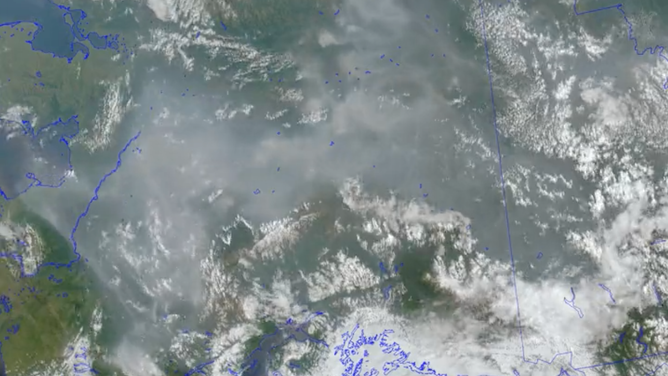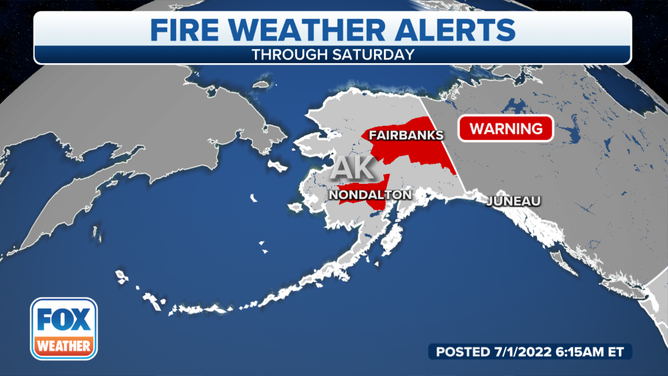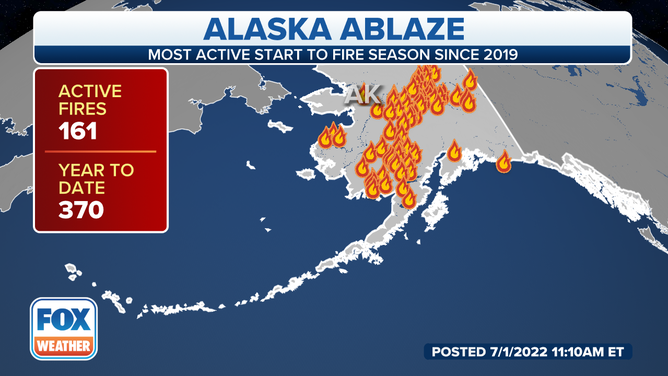NOAA satellites capture record wildfires enveloping Alaska in smoke
Air quality is very unhealthy across central and eastern Alaska due to widespread smoke
NOAA satellites show Alaska ablaze from space during record wildfire summer
NOAA satellites are providing wildfire data in Alaska where more than 300 fires have started this year, burning over 1.8 million acres. The fires have been fueled by dry weather and warm temperatures.
Satellites looking down from space are capturing important wildfire data in Alaska as smoke from more than 160 wildfires continues to billow across the state during a record wildfire summer.
The National Oceanic Atmospheric Administration has a handful of satellites that use different instruments to collect data and images of lightning, produce smoke models and detect changes in wildfire behavior. The GOES-16 and GOES-17 satellites can even detect fires from space before they are spotted from the ground, according to NOAA, which is helpful in remote Alaskan areas.
As of Friday, 161 fires were actively burning across the state and more than 1.8 million acres have been consumed by fires, according to the Alaska Interagency Coordination Center Wildland Fire Dashboard.
On Thursday, the state elevated from Preparedness Level 4 to Level 5, dedicating extended resources to new and existing fires.
Critical fire weather and lightning are fueling this summer's record wildfire season across Alaska.
HOW DO WILDFIRES AND THEIR SMOKE EXACERBATE MEDICAL CONDITIONS?
On Thursday, more than 2,000 lightning strikes were recorded in Alaska and neighboring territories, according to the dashboard.
Lightning started the East Fork Fire on May 31, which has now burned over 250,000 acres and is one of the largest tundra fires on record. NOAA-20 and Suomi NPP are tracking fires like the East Fork Fire in remote areas, which significantly slowed over the past week.
GOES satellites provide real-time imagery of fire smoke, showing where it's moving. On Thursday, GOES-17 (GOES-West) showed widespread coverage of smoke across much of Alaska.

NOAA satellite GOES17/GOES West shows widespread coverage of smoke across Alaska. (Image: NOAA/UW-Madison CIMSS)
Another instrument on GOES-17 was able to record the temperatures of a 50-mile-long wildfire near Iliamna Lake in southwestern Alaska in infrared light and actual color.
Wildfires create unhealthy air quality
Due to the fire activity, the Alaska Department of Environmental Conservation issued Air Quality Advisories throughout June that will continue for July.
According to the Alaska DEC, the air quality in central and eastern Alaska could be "very unhealthy" depending on wind and proximity to the fire.
Active Air Quality Advisories are in effect for the central and eastern interior, south-central, southwestern and the Aleutians and western interior.
7 FACTS THAT EXPLAIN HOW AIR QUALITY IS MEASURED
Fire Weather Warnings this weekend

Fire Weather Warnings are in effect for parts of Alaska through Saturday. Scattered thunderstorms are expected, and with very dry conditions, new fires are possible, warns the NWS Fairbanks.
Fire danger is extremely high into the July Fourth weekend. Fire Weather Warnings are in effect for parts of Alaska through Saturday.
According to the National Weather Service in Fairbanks, scattered thunderstorms are forecast through the weekend. Combined with the recent lack of rain and very dry conditions, new fires are possible, the NWS Fairbanks warns.
MEET THE METEOROLOGISTS WHO HEAD TOWARD THE HEART OF A FIRE
Fire Weather Warnings are in place for central and eastern interior Alaska, including Fairbanks and areas north and west of Denali Park. In southwestern Alaska, warnings for dry and windy conditions are in effect until 1 a.m. Alaska time Saturday for the Middle Kuskokwim Valley and Western Alaskan Range.
Temperatures will remain in the 80s, with relative humidity in the mid-20% range this weekend. Southerly winds will be gusting up to 10 mph.
An emergency burn closure order is in place, restricting all burning in the state that requires a burn permit, according to Alaska’s Division of Forestry & Fire Protection.

Active fires and total fires this year in Alaska.
(FOX Weather)
The fires are impacting tourism in Alaska, which sees a boost during this time of year. Several campgrounds and recreational cabin areas have been forced to close due to the Middle Fork Fire near the Chena River Recreation Area.
Heavy smoke from the Fish Fire has reduced visibility in some areas along Dalton Highway near the Arctic Circle Campground. Drivers are asked to travel with extreme caution in smoky areas.
CLICK HERE TO GET THE FOX WEATHER UPDATE PODCAST
The Bureau of Land Management temporarily closed access on Thursday to the western part of the White Mountains National Recreation Area due to wildfire activity from the Minto Lakes Fire.
Heading into the holiday weekend, nearly 1,000 personnel are actively fighting about 20 fires across the state, including highly trained smokejumpers who deploy into the wildfires.
